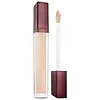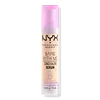What's inside
What's inside
 Key Ingredients
Key Ingredients

 Benefits
Benefits

 Concerns
Concerns

 Ingredients Side-by-side
Ingredients Side-by-side

Water
Skin ConditioningCyclopentasiloxane
EmollientPhenyl Trimethicone
Skin ConditioningMica
Cosmetic ColorantButylene Glycol
HumectantCetyl PEG/PPG-10/1 Dimethicone
EmulsifyingPvp
Emulsion StabilisingPEG-10 Dimethicone
Skin ConditioningCI 77120
Cosmetic ColorantSodium Chloride
MaskingVinyl Dimethicone/Methicone Silsesquioxane Crosspolymer
Aluminum Hydroxide
EmollientCamellia Sinensis Leaf Extract
AntimicrobialCentella Asiatica Extract
CleansingChamomilla Recutita Flower Extract
MaskingDimethicone
EmollientDisteardimonium Hectorite
StabilisingGlycyrrhiza Glabra Root Extract
BleachingMethicone
EmollientMyristic Acid
CleansingPalmitic Acid
EmollientPolygonum Cuspidatum Root Extract
AntioxidantPolysilicone-11
Rosmarinus Officinalis Leaf Extract
AntimicrobialScutellaria Baicalensis Root Extract
AstringentSqualane
EmollientStearic Acid
CleansingTriethoxycaprylylsilane
Chlorphenesin
AntimicrobialPhenoxyethanol
PreservativeCI 77891
Cosmetic ColorantIron Oxides
Water, Cyclopentasiloxane, Phenyl Trimethicone, Mica, Butylene Glycol, Cetyl PEG/PPG-10/1 Dimethicone, Pvp, PEG-10 Dimethicone, CI 77120, Sodium Chloride, Vinyl Dimethicone/Methicone Silsesquioxane Crosspolymer, Aluminum Hydroxide, Camellia Sinensis Leaf Extract, Centella Asiatica Extract, Chamomilla Recutita Flower Extract, Dimethicone, Disteardimonium Hectorite, Glycyrrhiza Glabra Root Extract, Methicone, Myristic Acid, Palmitic Acid, Polygonum Cuspidatum Root Extract, Polysilicone-11, Rosmarinus Officinalis Leaf Extract, Scutellaria Baicalensis Root Extract, Squalane, Stearic Acid, Triethoxycaprylylsilane, Chlorphenesin, Phenoxyethanol, CI 77891, Iron Oxides
Water
Skin ConditioningHydrogenated Polyisobutene
EmollientHydrogenated Polydecene
EmollientPolyglyceryl-3 Diisostearate
EmulsifyingGlycerin
HumectantTrimethylsiloxysilicate
EmollientIsononyl Isononanoate
EmollientDisteardimonium Hectorite
StabilisingButylene Glycol
HumectantSilica
AbrasiveCamellia Sinensis Leaf Extract
AntimicrobialHelianthus Annuus Seed Oil
EmollientTremella Fuciformis Polysaccharide
Emulsion StabilisingCentella Asiatica Extract
CleansingAllantoin
Skin ConditioningSorbitan Olivate
EmulsifyingSorbitan Sesquiisostearate
EmulsifyingGlyceryl Behenate/Eicosadioate
EmollientSodium Chloride
MaskingMagnesium Sulfate
Ethylhexylglycerin
Skin ConditioningPolyhydroxystearic Acid
EmulsifyingTocopherol
AntioxidantPhenoxyethanol
PreservativeCI 77491
Cosmetic ColorantCI 77492
Cosmetic ColorantCI 77499
Cosmetic ColorantCI 77891
Cosmetic ColorantCeramide AP
Skin ConditioningWater, Hydrogenated Polyisobutene, Hydrogenated Polydecene, Polyglyceryl-3 Diisostearate, Glycerin, Trimethylsiloxysilicate, Isononyl Isononanoate, Disteardimonium Hectorite, Butylene Glycol, Silica, Camellia Sinensis Leaf Extract, Helianthus Annuus Seed Oil, Tremella Fuciformis Polysaccharide, Centella Asiatica Extract, Allantoin, Sorbitan Olivate, Sorbitan Sesquiisostearate, Glyceryl Behenate/Eicosadioate, Sodium Chloride, Magnesium Sulfate, Ethylhexylglycerin, Polyhydroxystearic Acid, Tocopherol, Phenoxyethanol, CI 77491, CI 77492, CI 77499, CI 77891, Ceramide AP
 Reviews
Reviews

Ingredients Explained
These ingredients are found in both products.
Ingredients higher up in an ingredient list are typically present in a larger amount.
Butylene Glycol (or BG) is used within cosmetic products for a few different reasons:
Overall, Butylene Glycol is a safe and well-rounded ingredient that works well with other ingredients.
Though this ingredient works well with most skin types, some people with sensitive skin may experience a reaction such as allergic rashes, closed comedones, or itchiness.
Learn more about Butylene GlycolCamellia Sinensis Leaf Extract is derived from the leaves of the tea plant. Black tea, green tea, and oolong tea are all harvested from this plant.
This ingredient has many skin benefits:
This ingredient contains polyphenols, a strong antioxidant. Antioxidants help fight off molecules that damage skin cells.
On top of that, the antioxidants in green tea neutralize free-radicals from the sun. This gives the skin some extra UV protection, but should not replace sunscreen.
Many components of tea have anti-inflammatory properties.
Polyphenols and L-theanine help soothe the skin and reduce irritation. The caffeine in Camellia Sinensis Leaf Extract helps calm inflamed blood vessels.
Other compounds found in tea include: Vitamin Bs, linoleic acid, magnesium, calcium, iron, and zinc.
Research has shown both drinking Camellia Sinensis Leaf Tea and applying it to the skin can help boost skin elasticity and hydration. Studies also show using tea extract may reduce sebum, or oil, production.
Learn more about Camellia Sinensis Leaf ExtractCentella Asiatica Extract (Centella) is derived from an herb native to Southeast Asia. It is famous for its anti-inflammatory and soothing properties.
Centella is rich in antioxidants and amino acids, such as Madecassic Acid and Asiaticoside.
Studies show the compounds in centella help with:
The combination of all these properties makes centella effective at soothing, hydrating, and protecting the skin.
Other great components of centella include Vitamin A, vitamin C, several B vitamins, and Asiatic Acid.
Fun fact: Centella has been used as a medicine and in food for many centuries. As a medicine, it is used to treat burns, scratches, and wounds.
Learn more about Centella Asiatica ExtractCi 77891 is a white pigment from Titanium dioxide. It is naturally found in minerals such as rutile and ilmenite.
It's main function is to add a white color to cosmetics. It can also be mixed with other colors to create different shades.
Ci 77891 is commonly found in sunscreens due to its ability to block UV rays.
Learn more about CI 77891Disteardimonium Hectorite comes from the clay mineral named hectorite. It is used to add thickness to a product.
It can also help stabilize a product by helping to disperse other ingredients.
Hectorite is a rare, white clay mineral.
Learn more about Disteardimonium HectoritePhenoxyethanol is a preservative that has germicide, antimicrobial, and aromatic properties. Studies show that phenoxyethanol can prevent microbial growth. By itself, it has a scent that is similar to that of a rose.
It's often used in formulations along with Caprylyl Glycol to preserve the shelf life of products.
Chances are, you eat sodium chloride every day. Sodium Chloride is also known as table salt.
This ingredient has many purposes in skincare: thickener, emulsifier, and exfoliator.
You'll most likely find this ingredient in cleansers where it is used to create a gel-like texture. As an emulsifier, it also prevents ingredients from separating.
There is much debate on whether this ingredient is comedogenic. The short answer - comedogenic ratings don't tell the whole story. Learn more about comegodenic ratings here.
The concensus about this ingredient causing acne seems to be divided. Research is needed to understand if this ingredient does cause acne.
Scrubs may use salt as the primary exfoliating ingredient.
Learn more about Sodium ChlorideWater. It's the most common cosmetic ingredient of all. You'll usually see it at the top of ingredient lists, meaning that it makes up the largest part of the product.
So why is it so popular? Water most often acts as a solvent - this means that it helps dissolve other ingredients into the formulation.
You'll also recognize water as that liquid we all need to stay alive. If you see this, drink a glass of water. Stay hydrated!
Learn more about Water